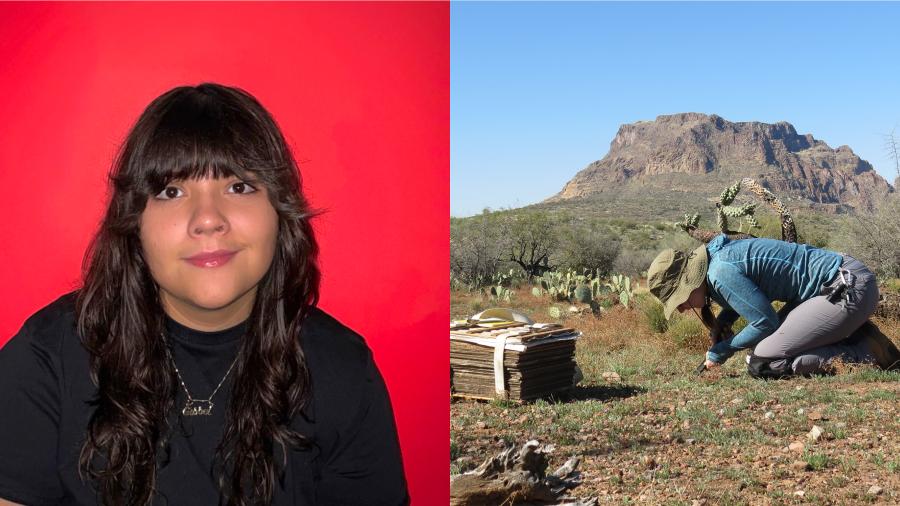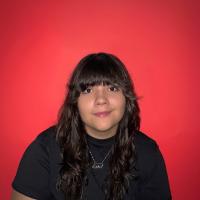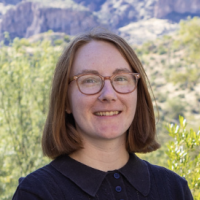Souls of SOLS, May: Highlighting Graduate Student Stories

Left: Gissel Marquez Alcaraz, third-year PhD student studying evolutionary biology. Right: Brit Burgard, second-year master's student studying plant biology and conservation, digging in front of Picketpost Mountain.
Note: This story is part of an ongoing series profiling graduate students in the School of Life Sciences. See April's featured students here.
Gissel Marquez Alcaraz – Evolutionary Biology
What do cancer, cacti, and kombucha have in common?
For Gissel Marquez Alcaraz, a third year PhD candidate in the Evolutionary Biology program, they’re all model systems for studying evolution.
Marquez Alcaraz has been interested in studying cancer since she was an undergraduate. She read Athena Aktipis, a psychologist at ASU, speaking about adaptive therapy during an interview. Rather than attempting to eradicate cancer cells, adaptive therapy seeks to control tumors to keep them from spreading, which could prolong the lives of people who have cancer.
“It was this idea of possibly controlling cancer and allowing people to live with it. That’s what initially led me to reach out to [Aktipis],” Marquez Alcaraz explains. “And [Aktipis] told me, ‘I actually don't have a cancer lab right now. But I have space in my kombucha lab. If you do the kombucha work now, maybe you can do the cancer work later.’”
So, throughout her bachelor’s, Marquez Alcaraz worked for and eventually ran the kombucha project in the Cooperation lab, studying how yeast and bacteria in kombucha cooperate and compete, as well as how the system evolves in response to disturbances. When she started her PhD, she finally got the chance to start researching cancer, too.
After joining the Cancer and Evolution lab, Marquez Alcaraz followed her curiosities. She began investigating cancer in saguaro cacti, which, when infected, start branching out in alien-looking crests and folds.
“I see (cancer in cacti) as more of a metaphor. If I can tell people a cactus has cancer, and it lived for 200 years, and it was probably one of the most iconic things in the hiking trail for years and years, maybe people can be inspired by that.”
But Marquez Alcaraz mostly focuses on developing treatments for humans. She both looks at whether certain types of probiotics can help improve cancer treatment outcomes and tests adaptive therapy techniques in mice models, all with the hope of improving the lives of people who have cancer. She also co-directs the ACE scholars' program, which employs over 60 undergraduate researchers who are all studying cancer, too.
“Cancer treatment is so harsh. I see it, I work with it, and I hate it. If we can provide people with something less strenuous on the body, like a probiotic, and that can help their cancer treatment, that’s awesome. And with adaptive therapy, prolonging people’s lives would be an incredible achievement. I want to get cancer to a point where people can live with it rather than having it be a death sentence at its later stages.”
Brit Burgard – Plant Biology and Conservation
Anyone who lives in the western US has probably heard of wildfires near where they live, if they haven’t encountered them directly. One hit particularly close to home for Brit Burgard, a second-year master’s student in the Plant Biology and Conservation program. In 2021, she was living in Superior, Arizona, when the Telegraph Fire hit, which burned over 180,000 acres –– about the area of Austin, Texas.
Burgard was working at the Boyce Thompson Arboretum then and was part of the effort to help protect the garden against the fire. Afterwards, when she began her master’s at ASU, she wondered what the wildfire’s effects on the desert were.
“Wildfire is increasing in the Sonoran Desert as a result of climate change and invasive species,” Burgard explains. “That increase was something I wanted to look at because the Sonoran Desert isn't considered fire adapted. But we don't necessarily know a lot about how fire affects individual species, and we can clearly see that some of the larger sort of keystone species are affected negatively.”
To begin understanding how the Sonoran Desert reacts to wildfire, Burgard conducted a flora, or catalog of species, along the perimeter of the area burned by the Telegraph fire within the desert. So far, she’s found that some species, like brittlebush and globe mallow, can return well after a fire, as fire releases some nutrients into the soil. But other species, like saguaro, might not be able to bounce back so easily.
With that in mind, Burgard has also spent much of her master’s conducting research att he Boyce Thompson Arboretum on saguaro restoration. She monitors how young saguaros grow when planted at different ages and with differing access to water to inform researchers who will try to replant saguaros in the future.
“It was very fun to do that. When I worked at BTA, I actually seeded the saguaro (that I used for the project. So it was great to come back to them.”
That work, which she does outside of her master’s thesis, has largely been funded by the Benson award, which is awarded to graduate students who want to do conservation research at the arboretum. Burgard has won the award twice.
“I’m extremely honored to have received that award. It was really awesome because it allowed me to focus on my work.”
By studying both the after effects of wildfire and looking into strategies to help the desert rebound, Burgard’s work should help other researchers better protect the Arizona wilderness in the face a of a changing climate.

